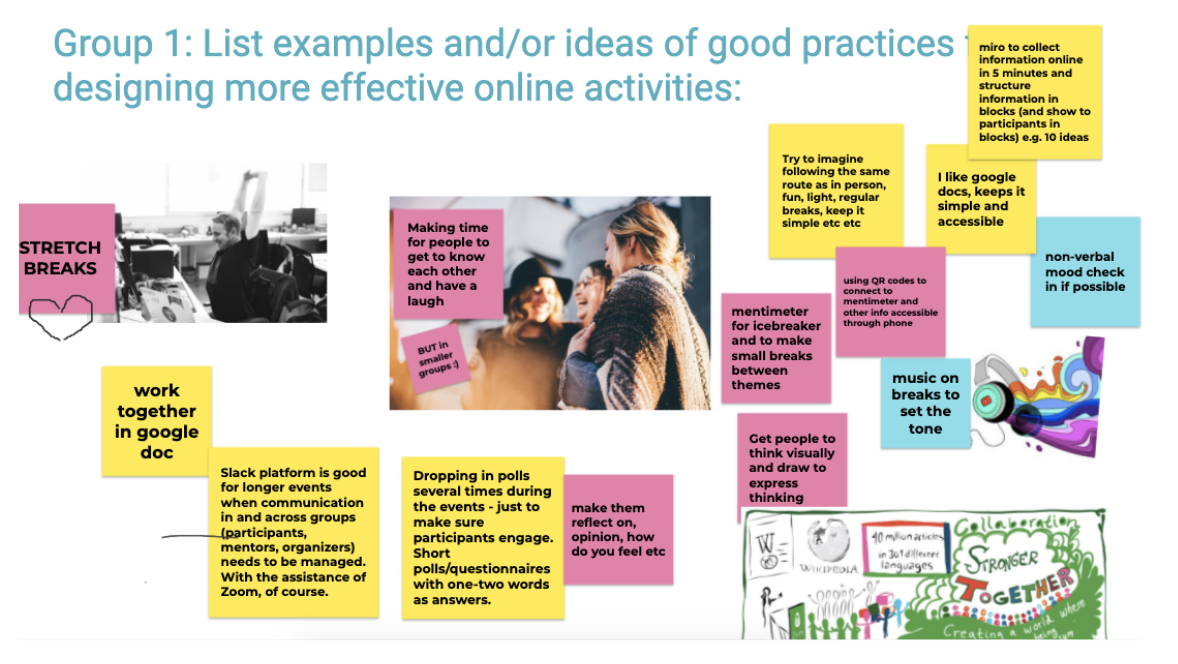Want Engaging Online Activities? Here are 20 Ideas
/Online activities and tools can be a highly effective way to make participatory processes more accessible and inclusive, but there are some challenges when designing them.
About 25 members from the People Powered community discussed those roadblocks in a peer-learning workshop called "Designing Effective Online Learning Activities," facilitated by Vinícius Zunino (manager of the Ambassadors Program for Politize!) and Amanda Luz (learning design fellow at People Powered). Common challenges they identified included "online learning can just copy face-to-face teaching and get boring very soon” and “there can be a lack of human connection and screen fatigue.”
Here are some of the solutions they suggested:
1. Get people to think visually and draw to express their input. Digital collaborative boards are great for non-verbal collaboration. Below is a screenshot of the Jamboard used in the workshop. Other good options to explore are Miro, Mural, and Padlet.
2. Work together in Google docs so everyone can see each other’s contributions real time.
3. Use the Slack platform for longer events, when communication in and across groups (participants, mentors, organizers) needs to be managed. With the assistance of Zoom, of course.
4. Incorporate polls several times into an event to make sure participants engage. Ideally, make polls short, offering check-boxes or questions requiring one- or two-word answers. Mentimeter is a great application that can be integrated into Zoom. If you need a simpler solution, use the Zoom survey function or ask participants to type in the chat.
5. Use QR codes to allow your participants to connect to Mentimeter and other information accessible through phones. This is helpful if you know your audience is connecting mostly from mobile phones or that there is more than one person on the same computer screen.
6. Add stretch breaks. As you would do in person, build regular breaks into the agenda even if the meeting is short. People have long days, especially if they are listening to a language that is not native for them and learning new things. Also, remember that Zoom fatigue is real!
7. Give instructions and demonstrations on how to use new tools at the start of the activity.
8. Make time for people to get to know each other and laugh. But do so in smaller breakout groups, where people can get into conversations. You can switch who is in which group a couple of times to make sure everyone meets each other.
9. Include language interpreters, as well as transcription and/or sign language interpretation, whenever possible if participants are coming from multiple countries or have learning challenges. (This is a good thing to ask about when participants register!).
10. Provide monthly stipend for broadband internet access to individuals who cannot join in remote learning sessions.
11. Break a silence with a "noisy moment," when everyone switches on their microphones and speaks at once. In the image below, everyone was saying their last words and "goodbyes" together.
12. Ask how participants feel, since it's harder to detect online. You can also use nonverbal signaling for emotional check-ins. For example, use color scales, number scales, or blob trees.
13. Link learning strategies with participants' realities to make them bring their life to the virtual learning environment.
14. Choose skilled facilitators to moderate breakout groups and/or offer guiding prompts that support collaboration.
15. Send lots of reminders about meetings and tasks. Schedule them in advance to save time.
16. Take extra care of course trainers and facilitators, if you are not one of them. In the online context, they are not getting “buzz” from the room. They can feel a little "flat" during an online session, try to answer and engage if you are willing to do so.
17. Share preparation documents with participants before the meeting, if possible. Sharing videos or reading materials that can be reviewed individually also saves time that is precious together.
18. Try not to replicate "offline" interactions during online activities. For example, watching videos together might be more tiresome or distracting over Zoom. Instead, you can send out materials for participants to review before the session and they can discuss when meeting online.
19. Allow a much larger portion of time than you do during in-person meetings for "non-core" activities, to build atmosphere and engagement.
20. Acknowledge that online learning can feel "strange" sometimes. Being vulnerable helps!






